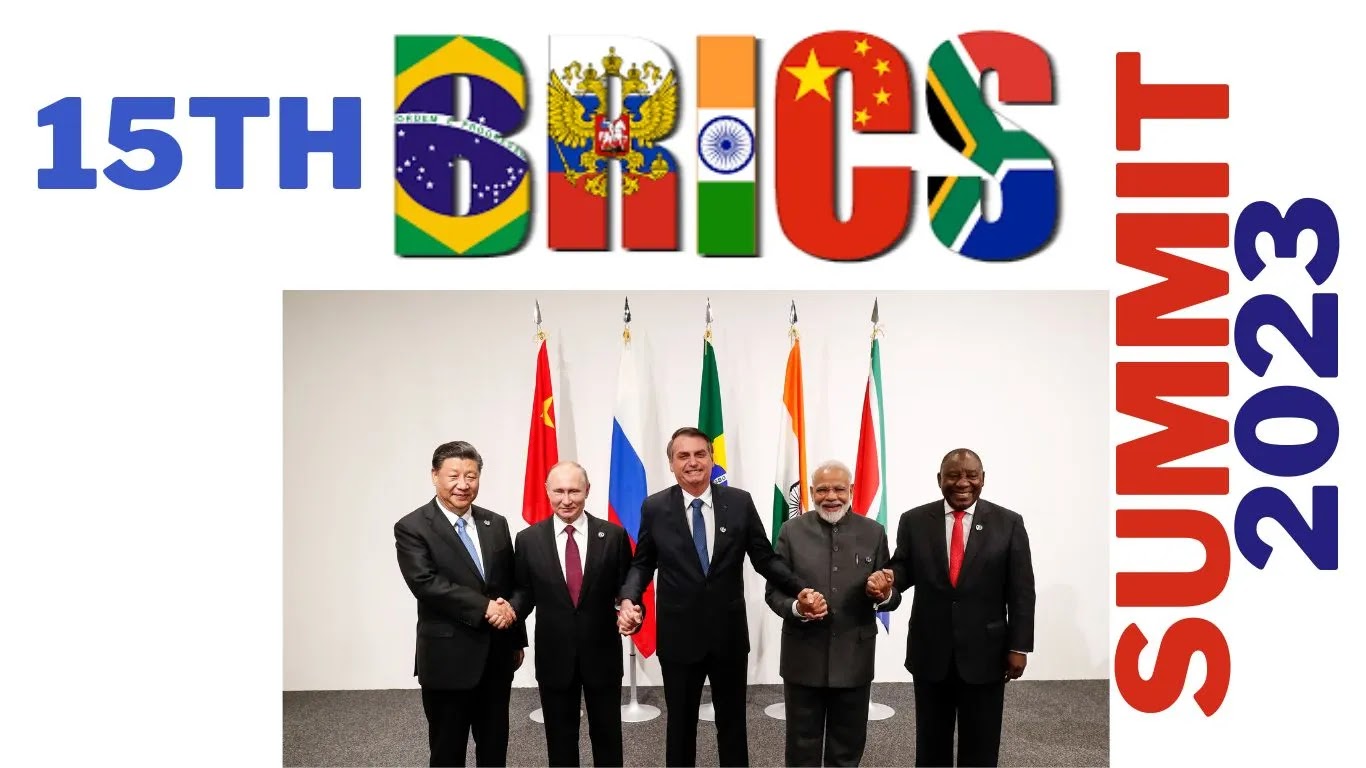Short
view on 15th BRICS Summit 2023
The 15th BRICS Summit, hosted by South African President
Cyril Ramaphosa, has garnered significant attention due to its geopolitical and
geoeconomic context. BRICS comprises Brazil, Russia, India, China, and South
Africa.
- This summit
holds increased importance in light of recent events, particularly the war in
Ukraine, which has created geopolitical instability.
Key
Points About BRICS Summit 2023:
The summit marks a significant moment as it is the first
in-person gathering since the COVID-19 pandemic disrupted the previous
summit in 2019.
The pandemic’s remnants affected China in 2022, leading to a
virtual summit that year.
Additionally, the Russian invasion of Ukraine in 2022
has added a layer of complexity to global stability, including food,
fertilizer, and energy security.
BRICS
discussions are often seen with a “counter-western” perspective,
and this summit holds significance as the U.S. and EU seek to isolate Russia
due to the conflict.
Indian Context:
For India, the summit carries unique importance. It’s the
first in-person summit since the 2020 military standoff with China along
the Line of Actual Control.
Prime Minister Narendra Modi and President Xi Jinping
will interact within a small group, presenting opportunities for bilateral
talks.
The recent
joint statement from India-China Corps Commander Level Meeting indicates
positive steps towards resolving the LAC situation.
B – Breaking barriers
R – Revitalising economies
I – Inspiring Innovation
C – Creating opportunities
S – Shaping the future
The government of India highlighted the following:
- Called for setting
defined timelines for UNSC reforms - Called for reform of Multilateral Financial Institutions
- Called for reform of WTO
- Exhorted BRICS to build consensus on its expansion
- Urged BRICS to send a global message of unity and not
polarisation - Proposed creation of a BRICS Space Exploration Consortium
- Offered Indian Digital Public Infrastructure – the Indian
stack to BRICS partners - Proposed undertaking skill mapping, skilling and promoting
mobility among BRICS countries - Proposed joint efforts of BRICS countries for protection of
Big Cats under International Big Cat Alliance - Proposed establishing a repository of traditional medicine
among BRICS countries - Called upon BRICS partners to support AU’s permanent
membership of the G20
Aim & Theme:
The summit aims to address various global issues, such as
the expansion of BRICS, intra-BRICS trading in national currencies, and
global developments.
South
Africa’s theme for the summit, “BRICS and Africa: Partnership for
Mutually Accelerated Growth, Sustainable Development, and Inclusive
Multilateralism,” focuses on climate change, the African Continental
Free Trade Area, and women’s participation in peace processes.
Leaders from
BRICS countries, including Narendra Modi, Xi Jinping, and Brazilian President
Lula, will deliberate on the “Johannesburg Declaration.”
However, Russian President Vladimir Putin’s absence is notable due to an ICC
warrant against him. BRICS has extended invitations to African Union members
and other leaders from developing countries to promote economic cooperation.
While the
summit could explore matters like a “BRICS currency” and
global initiatives, the focus seems to remain on economic issues. India’s
engagement is essential as it faces critical challenges with China at the LAC and
seeks to promote cooperation within the BRICS framework.
Overall, the BRICS Summit of 2023 assumes greater importance
given the shifting geopolitical landscape and the need to address economic and
global challenges collectively.
About BRICS:
BRICS is an acronym that represents a group of five major
emerging economies: Brazil, Russia, India, China, and South Africa. The
term was originally coined by Goldman Sachs in a report in 2001 to
highlight the significant economic potential of these countries. Over time,
BRICS has evolved into a formal alliance for cooperation and dialogue among its
member nations.
Here are the basic points about BRICS:
1. Member Countries: BRICS consists of five member
countries – Brazil, Russia, India, China, and South Africa. These countries
span different continents and have diverse economic, political, and cultural
backgrounds.
2. Economic Focus: BRICS countries are characterized
by their large and fast-growing economies. They are collectively considered to
be major players in the global economy and are among the world’s largest
economies by GDP.
3. Cooperation and Dialogue: BRICS serves as a
platform for member countries to engage in discussions, collaboration, and
mutual support on a range of issues, including economic development, political
cooperation, and global challenges.
4. Annual Summits: BRICS holds annual summits where
leaders from member countries gather to discuss various issues of mutual
interest. These summits provide an opportunity for high-level diplomatic engagement
and decision-making.
5. Geopolitical Influence: BRICS countries
collectively wield significant geopolitical influence and represent a
significant portion of the world’s population. They often work together to
advocate for their interests and viewpoints on global matters.
6. New Development Bank (NDB): One of the notable
achievements of BRICS is the establishment of the New Development Bank, also
known as the BRICS Bank. The NDB provides funding for infrastructure and
sustainable development projects in member countries and other emerging
economies.
7. Contingent Reserve Arrangement (CRA): Another key
initiative is the Contingent Reserve Arrangement, which is a financial safety
net designed to provide member countries with the ability to access emergency
funds to address balance of payments problems.
8. South-South Cooperation: BRICS represents a form
of South-South cooperation, where countries from the global South come together
to address common challenges and promote shared development goals.
9. Diverse Agenda: While economic cooperation is a
primary focus, BRICS discussions also cover a wide range of topics, including
political coordination, global governance reform, security matters,
technological collaboration, and cultural exchanges.
10. Voice in Global Affairs: BRICS provides its
member countries with a collective platform to voice their perspectives on
global issues, which may differ from those of traditional Western powers. This
often leads to a more balanced and inclusive discourse in international
relations.
11. Share of BRICS Nations: Together, BRICS accounts
for about 41% of the world’s population and about 24% of the GDP (Gross
Domestic Product), 16% of the global trade.
Overall, BRICS is a significant geopolitical and economic
alliance that brings together five major emerging economies to collaborate,
discuss common challenges, and promote their interests on the global stage.
|
UPSC Prelims PYQ on BRICS:
Que. Consider the following
1. 2. Which of the statements given
a) b) c) d)
Answer (b) Explanation: The New Development Bank (NDB) The NDB is headquartered in |
Solve: MCQ on BRICS Summit 2023
|
Frequently Q1: What is BRICS? BRICS is an acronym Q2: When was BRICS The term Q3: What is the BRICS serves as a Q4: How often do BRICS summits are held Q5: What are some BRICS has established Q6: Is BRICS solely While economic Q7: How does BRICS BRICS countries Q8: What is the role The NDB, established by Q9: How has the Global events such as Q10: How does BRICS BRICS represents a form Q11: What is the The 15th BRICS Summit Q12: How does the The BRICS Summit allows Q13: What are some Topics often discussed Q14: Is BRICS open Yes, BRICS has shown
Q15: How does BRICS BRICS challenges the These FAQs provide a |
Reference: TH

